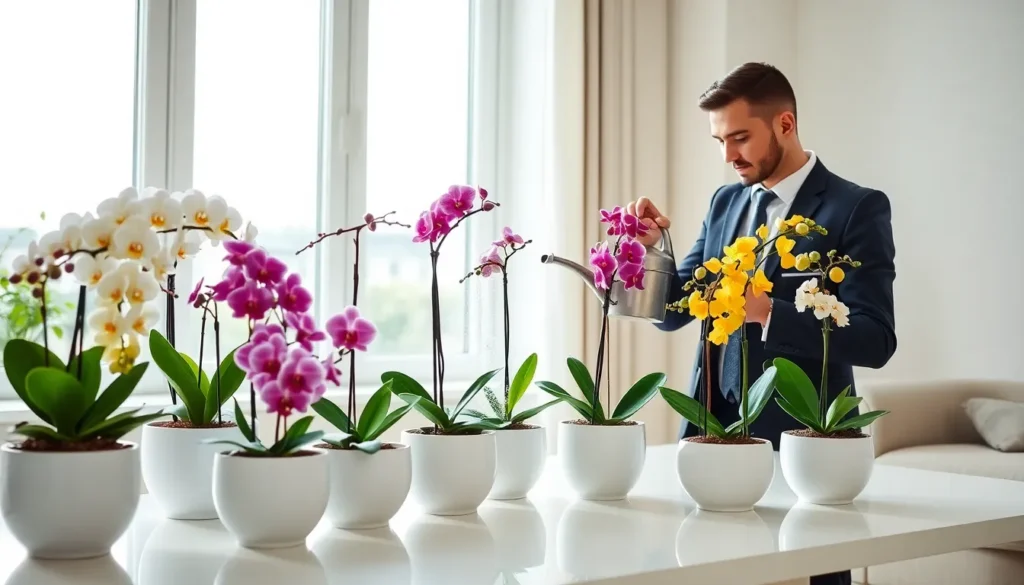Table of Contents
ToggleOrchids are like that friend who always looks elegant at parties but is secretly a bit high-maintenance. They captivate with their mesmerizing blossoms, yet many people struggle to keep these beauties alive. If you’ve ever wanted to nurture an orchid but found yourself daunted by their reputation, you’re not alone. Luckily, with the right guidance, caring for an orchid can be both straightforward and rewarding. Jump into the world of these regal plants and discover the care tips that will keep your orchid thriving and looking fabulous.
Understanding Orchids

Orchids are a diverse family of plants, with more than 25,000 species known to science. This variety means there are orchids for almost every taste. Each type has its unique charm and care requirements.
Types of Orchids
Among the most popular are Phalaenopsis, known for their beautiful, butterfly-like flowers, and Cattleya, celebrated for their striking colors and scents. Other varieties, such as Dendrobium and Oncidium, also bring unique aesthetics and care requirements. Knowing which type you own is the first step toward success in orchid care.
Natural Habitat and Growth Patterns
Most orchids are epiphytes, meaning they primarily grow on other surfaces like tree trunks rather than in soil. This growth habit affects how you should set up and care for your orchid at home. After all, if in the wild orchids can cling to trees, it’s likely they prefer their roots to have plenty of air. Mimicking their natural conditions can make a world of difference in how your orchid thrives.
Essential Care Guidelines
Caring for an orchid isn’t about constant attention: rather, it’s about understanding its basic needs.
Watering Techniques
Watering can be a tricky balance. Overwater, and you risk root rot: underwater, and your orchid may just wilt. A good rule of thumb is to water every 1-2 weeks, allowing the potting medium to dry slightly between watering. When you do water, make sure to thoroughly soak the plant, letting water drain out of the bottom. Remember, orchids prefer their roots to dry out a bit before the next round.
Lighting Requirements
Orchids crave bright, indirect light. Direct sunlight can scorch their leaves, while too little light can stunt growth. A spot near an east or south-facing window often does the trick. If you notice your orchid stretching toward the light, it’s telling you it needs a brighter spot.
Temperature and Humidity Needs
Most orchids enjoy temperatures around 70-85°F during the day and slightly cooler at night. They also appreciate humidity levels of 50-70%. If your home is dry, consider using a pebble tray filled with water to boost humidity or a humidifier in the room.
Fertilizing Your Orchid
Just like us, orchids need nutrition to flourish. The right fertilizer makes all the difference. During the growing season, apply a balanced orchid fertilizer every two weeks, then switch to monthly during the dormant phase. Look for a fertilizer with a higher phosphorus content, it encourages blooming, which is the goal, right? Just remember, it’s better to under-fertilize than overdo it.
Potting and Repotting
Orchids thrive in well-draining potting media, which often consists of materials like bark, charcoal, and sphagnum moss. When it’s time to repot, about every couple of years, choose a pot that allows for airflow. If roots are crammed, it’s time to give your orchid some space. Check for any dead or mushy roots while repotting, and trim those away to promote healthy growth.
Common Orchid Problems and Solutions
Even with the best care, issues can arise. Knowing how to troubleshoot can save your plant.
Pests and Diseases
Watch for common pests like aphids, mealybugs, and spider mites. If you spot these unwelcome guests, wipe the leaves with a gentle soap solution or neem oil to get rid of them. Fungal and bacterial infections can also occur, usually as a result of overwatering. If your orchid’s leaves start turning yellow or brown, check your watering habits.
Signs of Stress in Orchids
Just like humans, orchids can show signs of stress. Yellow leaves? It might be a sign of overwatering. If leaves drop unexpectedly, check the temperature or light levels. Identifying these signals early can help your orchid bounce back swiftly.





